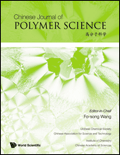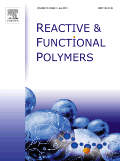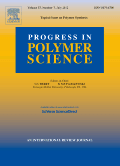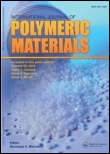
CELLULAR POLYMERS
Scope & Guideline
Connecting Scholars in Polymer Research
Introduction
Aims and Scopes
- Polymeric Foams Development:
Research on the synthesis and processing of various types of polymeric foams, including rigid, flexible, and semi-rigid foams, focusing on their mechanical, thermal, and physical properties. - Nanocomposite and Bio-based Materials:
Studies involving the incorporation of nanomaterials and bio-based components in polymer foams to enhance properties such as strength, thermal stability, and environmental sustainability. - Modeling and Characterization Techniques:
Utilization of advanced modeling techniques and characterization methods, including computed tomography and microstructural analysis, to better understand foam morphology and performance. - Applications in Insulation and Energy Absorption:
Exploration of the applications of cellular polymers in various fields, particularly in thermal insulation, sound absorption, and energy absorption materials. - Sustainable and Green Chemistry Approaches:
Focus on environmentally friendly synthesis methods and raw materials, including the use of renewable resources and the development of bio-based polyols.
Trending and Emerging
- Sustainable and Renewable Materials:
There is a growing trend towards the use of sustainable and renewable materials in the production of polymer foams, including bio-based polyols and natural fibers, highlighting the industry's shift towards eco-friendly practices. - Advanced Nanocomposites:
Research on the incorporation of nanomaterials, such as carbon nanotubes and nanosilica, into polymer foams is on the rise, as these materials significantly enhance mechanical, thermal, and fire-resistant properties. - Smart and Functional Foams:
Emerging studies focus on developing smart foams with responsive properties, such as self-healing capabilities and enhanced functionality for specific applications, reflecting a move towards multifunctional materials. - Modeling Techniques and Computational Approaches:
There is an increasing emphasis on utilizing computational modeling and advanced imaging techniques to design and characterize cellular structures, allowing for a deeper understanding of foam behavior. - Thermal and Acoustic Insulation Innovations:
Recent publications indicate a heightened interest in exploring innovative solutions for thermal and acoustic insulation, addressing the growing demand for energy-efficient and sound-absorbing materials.
Declining or Waning
- Traditional Polymeric Foams:
There is a noticeable decline in research focused solely on conventional polymeric foams without innovative modifications or enhancements, likely due to the increasing emphasis on advanced materials. - Simple Physical Blowing Agents:
Research on simple physical blowing agents for foam production has diminished, as newer techniques and more effective agents are being prioritized for improved performance. - Standardized Mechanical Testing:
The focus on basic mechanical property testing without detailed exploration of underlying mechanisms or advanced testing methods appears to be waning, as more complex analyses gain traction. - Generalized Applications in Construction:
While applications in construction remain relevant, specific studies solely addressing basic insulation properties without innovative approaches or materials are less frequently published.
Similar Journals

CHINESE JOURNAL OF POLYMER SCIENCE
Leading the Charge in Polymer Research ExcellenceThe CHINESE JOURNAL OF POLYMER SCIENCE, published by SPRINGER, stands as a premier periodical in the realm of polymer science, showcasing cutting-edge research and technological advancements since its inception in 1985. With an impressive impact factor reflecting its significance in the field, this journal is categorized in the top quartiles (Q1) of Chemical Engineering, Organic Chemistry, and Polymers and Plastics. It features a wide spectrum of innovative studies, thus serving as an essential resource for researchers, professionals, and students dedicated to understanding and advancing polymer-related technologies. The journal is indexed in Scopus, with notable rankings that highlight its influence in the disciplines of organic chemistry and materials science, making it a vital communication platform for authors around the globe aiming to disseminate impactful findings. Although not an open-access publication, the journal ensures robust accessibility through institutional subscriptions and partnerships, further emphasizing its commitment to the advancement of polymer science.

POLYMER INTERNATIONAL
Catalyzing Innovation in Polymers and PlasticsPOLYMER INTERNATIONAL is a leading journal in the field of polymer science, published by Wiley, one of the most esteemed scholarly publishers. With an ISSN of 0959-8103 and an E-ISSN of 1097-0126, this journal has been a pivotal platform for researchers since its inception in 1991, now extending its coverage until 2024. The journal boasts a commendable standing in various scientific domains, achieving a Q2 quartile ranking in Materials Chemistry, Organic Chemistry, and Polymers and Plastics as of 2023. Additionally, it holds impressive Scopus ranks, including Rank #47 in Organic Chemistry and Rank #40 in Polymers and Plastics, placing it within the top percentiles of its categories. Researchers, professionals, and students alike can benefit from its rich array of articles that contribute to the understanding and advancement of polymer technology and materials science. Although not an open access journal, POLYMER INTERNATIONAL remains crucial for disseminating high-quality research that drives innovation and development within the field.

JOURNAL OF POLYMER MATERIALS
Connecting Researchers to Polymer InnovationsJOURNAL OF POLYMER MATERIALS, published by PRINTS PUBLICATIONS PVT LTD, is a pivotal platform within the field of materials science, focusing particularly on polymer and plastics research. Established in 1987, this journal has played a crucial role in disseminating innovative findings and advances in polymer materials, catering to a diverse readership of researchers, professionals, and students alike. Despite a break in Scopus coverage, it continues to contribute valuable insights into materials chemistry, reflected in its rankings within the lower quartile in related categories. With an ISSN of 0973-8622, the journal seeks to foster a greater understanding of polymer science and applications. Researchers are encouraged to submit their findings to a journal that aims to bridge the gap between theoretical research and practical application. While currently not offering open access, readers can benefit from the journal's commitment to scholarly excellence. Located in New Delhi, India, the JOURNAL OF POLYMER MATERIALS remains a significant resource for those passionate about polymeric materials and their extensive applications.

REACTIVE & FUNCTIONAL POLYMERS
Advancing Polymer Science Through Innovation and CollaborationREACTIVE & FUNCTIONAL POLYMERS, published by Elsevier, is a leading journal in the field of polymer science, focusing on the innovative development and application of reactive and functional polymers. With an impressive impact demonstrated through its classification in various prestigious categories, including Q1 rankings in Chemical Engineering, Chemistry, and Materials Chemistry, this journal serves as an essential resource for researchers and professionals seeking to explore the latest advances in polymer research. With a broad scope that encompasses topics from biochemistry to environmental chemistry, and a convergence of significant findings from 1995 to 2024, REACTIVE & FUNCTIONAL POLYMERS fosters academic dialogue and collaboration among scientists. The journal also features Open Access options, ensuring that groundbreaking research is readily available to a global audience. By consistently publishing high-quality articles, it not only enriches the scientific community but also drives innovation across various industries reliant on polymer technologies.

POLYMERS & POLYMER COMPOSITES
Connecting Researchers in Polymer ExcellencePOLYMERS & POLYMER COMPOSITES, published by SAGE Publications Ltd, is a prestigious journal dedicated to the exploration of significant advancements in the diverse fields of polymers, composite materials, and their innovative applications. With an ISSN of 0967-3911 and E-ISSN of 1478-2391, this journal plays a crucial role in the academic community, boasting an impressive ranking in the Q2 quartile across pivotal categories such as Ceramics and Composites, Materials Chemistry, and Polymers and Plastics in 2023. Positioned in the United Kingdom, it serves as a vital resource for researchers and professionals, providing insights into current trends and future directions in material science. Despite its availability not extending to Open Access, the journal aims to promote rigorous peer-reviewed research, thus fostering knowledge and collaboration among scholars. With publication convergence from 1993 to 2024, POLYMERS & POLYMER COMPOSITES stands as a cornerstone for those pursuing advanced understanding and excellence in material innovation.

PROGRESS IN POLYMER SCIENCE
Empowering Researchers with High-Impact FindingsPROGRESS IN POLYMER SCIENCE is a prestigious academic journal published by PERGAMON-ELSEVIER SCIENCE LTD, dedicated to advancing the field of polymer science. With an ISSN of 0079-6700 and an E-ISSN of 1873-1619, this journal has established itself as a leading source of high-quality research since its inception in 1967. It ranks in the top quartile (Q1) across multiple categories including Ceramics and Composites, Materials Chemistry, Organic Chemistry, Polymers and Plastics, and Surfaces and Interfaces, reflecting its strong reputation and impact within the scientific community. The journal features rigorous peer-reviewed articles that not only contribute to theoretical advancements but also emphasize practical applications of polymer science in various industries. Although it is not an open-access journal, it remains accessible through institutional subscriptions and provides invaluable insights and data for researchers, professionals, and students alike. PROGRESS IN POLYMER SCIENCE is essential reading for anyone looking to stay abreast of the latest developments and innovations in this dynamic field.

POLYMER JOURNAL
Connecting Theory and Application in Polymer ResearchPOLYMER JOURNAL, published by SpringerNature in the United Kingdom, is a premier academic platform dedicated to the field of polymer science. Since its inception in 1971, this journal has become an essential resource for researchers and professionals interested in the latest advancements in materials chemistry, polymers, and plastics. With its robust H-index and a consistent ranking in the top quartiles of its categories—Q2 in both Materials Chemistry and Polymers and Plastics—POLYMER JOURNAL demonstrates a strong impact in the scientific community. It holds significant recognition in Scopus rankings, occupying the 68th percentile in Materials Chemistry and the 67th percentile in Polymers and Plastics. The journal's commitment to publishing high-quality research articles enables it to serve as a key reference point for innovative studies, theoretical developments, and practical applications in polymer science. Although it is not an open-access journal, researchers and students gain valuable insights through its extensive archives and rigorous peer-reviewed content, making POLYMER JOURNAL a vital source of knowledge for anyone engaged in this dynamic field.

POLYMER SCIENCE SERIES B
Innovating Materials Chemistry for TomorrowPOLYMER SCIENCE SERIES B is a distinguished journal published by MAIK NAUKA/INTERPERIODICA/SPRINGER, dedicated to advancing knowledge in the fields of ceramics and composites, materials chemistry, and polymers and plastics. The journal, identifiable by its ISSN 1560-0904 and E-ISSN 1555-6123, spans a significant timeline from 1996 to 2024, reflecting its commitment to preserving and disseminating cutting-edge research in polymer science. With its current ranking in the Q3 category across relevant fields, it supports scholars and professionals in enhancing their understanding and application of polymeric materials. While it operates on a non-open access basis, the journal is pivotal for researchers seeking in-depth analysis and peer-reviewed studies. Located in the heart of the United States at 233 Spring St, New York, NY 10013-1578, POLYMER SCIENCE SERIES B serves as an essential resource for committed researchers, professionals, and students aiming to push the boundaries of polymer science.

International Journal of Polymeric Materials and Polymeric Biomaterials
Advancing Research in Polymeric InnovationsThe International Journal of Polymeric Materials and Polymeric Biomaterials, published by Taylor & Francis AS, stands at the forefront of materials science, showcasing groundbreaking research in the fields of Analytical Chemistry, Chemical Engineering, and Polymeric Materials. With an ISSN of 0091-4037 and an E-ISSN of 1563-535X, this esteemed journal, established in 1971, serves as a vital platform for academics and professionals seeking to disseminate innovative findings and elevate the understanding of polymeric materials. Featuring a commendable impact factor and ranking in the top quartiles of its categories—Q2 in Analytical Chemistry, Chemical Engineering, and Polymers and Plastics—the journal is a pivotal resource for researchers aiming to leverage polymer science in various applications. Although it does not offer open access, its rigorous peer-review process ensures that only high-quality research is published, making it an essential reference for anyone involved in polymer research and development.

JOURNAL OF CELLULAR PLASTICS
Fostering Innovation in Polymer ScienceThe JOURNAL OF CELLULAR PLASTICS, published by SAGE PUBLICATIONS LTD, stands as a significant resource in the fields of Chemistry, Materials Chemistry, and Polymers and Plastics. With an ISSN of 0021-955X and an E-ISSN of 1530-7999, this esteemed journal has been contributing to scientific knowledge since its inception in 1965 and is slated to continue its impactful publication through 2024. Ranking in the Q2 category across its respective fields in 2023, and consistently positioned within the 61st to 63rd percentile in Scopus rankings, it is recognized for disseminating high-quality research that advances our understanding of cellular plastics. Although it operates under a subscription model, the journal remains dedicated to fostering scholarly discourse and innovation, making it an essential platform for researchers, industry professionals, and students eager to explore the latest advancements in polymer science.